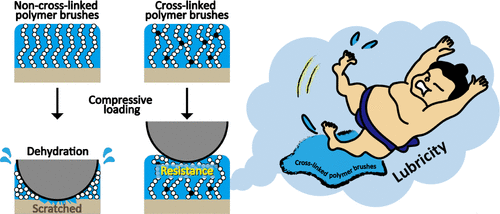当前位置:
X-MOL 学术
›
ACS Appl. Bio Mater.
›
论文详情
Our official English website, www.x-mol.net, welcomes your
feedback! (Note: you will need to create a separate account there.)
Highly Durable Lubricity of Photo-Cross-Linked Zwitterionic Polymer Brushes Supported by Poly(ether ether ketone) Substrate
ACS Applied Bio Materials ( IF 4.6 ) Pub Date : 2020-01-10 , DOI: 10.1021/acsabm.9b01040 Hiroki Nakano 1 , Yuri Noguchi 1 , Sachiro Kakinoki 2, 3 , Mai Yamakawa 4 , Issey Osaka 4 , Yasuhiko Iwasaki 2, 3
ACS Applied Bio Materials ( IF 4.6 ) Pub Date : 2020-01-10 , DOI: 10.1021/acsabm.9b01040 Hiroki Nakano 1 , Yuri Noguchi 1 , Sachiro Kakinoki 2, 3 , Mai Yamakawa 4 , Issey Osaka 4 , Yasuhiko Iwasaki 2, 3
Affiliation

|
For improving lubricity, the formation of zwitterionic polymer brushes on material surfaces is one of the most promising approaches. In this study, the photoreactive zwitterionic monomer 2-[2-(methacryloyloxy)ethyldimethylanmmonium] ethyl benzophenoxy phosphate (MBPP) was synthesized to improve the stability of zwitterionic polymer brushes. Although MBPP contains a benzophenone moiety in this molecule, it is water-soluble because of the zwitterionic linker. As a substrate, poly(ether ether ketone) (PEEK) was selected because it has recently been used to replace metals in orthopedic implants. Furthermore, PEEK is photosensitive, and UV graft polymerization of (meth)acrylic monomers on the surface can be performed without using any photoinitiators. Aqueous solutions containing various molar ratios of 2-(methacryloyloxy)ethyl phosphorylcholine (MPC) and MBPP were prepared, and the PEEK specimens were immersed in these solutions. UV light was used to irradiate the solutions for 180 min, and the formation of grafting layers of zwitterionic polymers on PEEK specimens was confirmed using contact angle measurement and X-ray photoelectron spectroscopy. The surface friction of PEEK was effectively reduced via the photopolymerization of zwitterionic monomers. However, the surface lubricity of poly(MPC) (PMPC)-grafted surface deteriorated during continuous friction because of the removal of PMPC from the surface. Nevertheless, the stability of polymer brushes was effectively improved by adding only 0.5–0.75 mol % of MBPP in the monomer solution. Moreover, the reduction of wear on the surface was determined using confocal laser microscopy. The excellent lubrication phenomenon was attributed to preserving the hydration state of grafted polymers under compressive stress. Moreover, bacterial adhesion on substrates was tested and observed on a neat PEEK and scratched regions of uncross-linked PMPC-grafted PEEK. Note that bacterial adhesion was completely suppressed on the surface of PEEK modified with cross-linked PMPC brushes with MBPP. Thus, we conclude that the surface modification of PEEK with MPC and MBPP can provide ideal surface properties for orthopedic devices.
中文翻译:

聚醚醚酮基材支撑的光交联两性离子聚合物刷的高耐久性润滑性
为了提高润滑性,在材料表面形成两性离子聚合物刷是最有前途的方法之一。本研究合成了光反应性两性离子单体 2-[2-(甲基丙烯酰氧基)乙基二甲基铵]乙基苯甲氧基磷酸酯 (MBPP),以提高两性离子聚合物刷的稳定性。尽管 MBPP 在该分子中含有二苯甲酮部分,但由于两性离子接头,它是水溶性的。选择聚醚醚酮 (PEEK) 作为基材是因为它最近已被用于替代骨科植入物中的金属。此外,PEEK具有光敏性,可以在不使用任何光引发剂的情况下,在表面进行(甲基)丙烯酸单体的UV接枝聚合。制备含有不同摩尔比的 2-(甲基丙烯酰氧基)乙基磷酸胆碱 (MPC) 和 MBPP 的水溶液,并将 PEEK 样品浸入这些溶液中。使用紫外光照射溶液 180 分钟,使用接触角测量和 X 射线光电子能谱确认 PEEK 样品上两性离子聚合物接枝层的形成。通过两性离子单体的光聚合有效降低了 PEEK 的表面摩擦力。然而,由于 PMPC 从表面上去除,聚 (MPC) (PMPC) 接枝表面的表面润滑性在连续摩擦过程中恶化。然而,聚合物刷的稳定性通过在单体溶液中仅添加 0.5-0.75 mol% 的 MBPP 得到有效提高。而且,使用共聚焦激光显微镜确定表面磨损的减少。优异的润滑现象归因于在压缩应力下保持接枝聚合物的水合状态。此外,在未交联的 PMPC 接枝 PEEK 的纯 PEEK 和划痕区域上测试和观察了细菌在基底上的粘附。请注意,用带有 MBPP 的交联 PMPC 刷子改性的 PEEK 表面上的细菌粘附被完全抑制。因此,我们得出结论,用 MPC 和 MBPP 对 PEEK 进行表面改性可以为骨科设备提供理想的表面特性。在未交联的 PMPC 接枝 PEEK 的纯 PEEK 和划痕区域上测试和观察了细菌在基底上的粘附。请注意,用带有 MBPP 的交联 PMPC 刷子改性的 PEEK 表面上的细菌粘附被完全抑制。因此,我们得出结论,用 MPC 和 MBPP 对 PEEK 进行表面改性可以为骨科设备提供理想的表面特性。在未交联的 PMPC 接枝 PEEK 的纯 PEEK 和划痕区域上测试和观察了细菌在基底上的粘附。请注意,用带有 MBPP 的交联 PMPC 刷子改性的 PEEK 表面上的细菌粘附被完全抑制。因此,我们得出结论,用 MPC 和 MBPP 对 PEEK 进行表面改性可以为骨科设备提供理想的表面特性。
更新日期:2020-01-10
中文翻译:

聚醚醚酮基材支撑的光交联两性离子聚合物刷的高耐久性润滑性
为了提高润滑性,在材料表面形成两性离子聚合物刷是最有前途的方法之一。本研究合成了光反应性两性离子单体 2-[2-(甲基丙烯酰氧基)乙基二甲基铵]乙基苯甲氧基磷酸酯 (MBPP),以提高两性离子聚合物刷的稳定性。尽管 MBPP 在该分子中含有二苯甲酮部分,但由于两性离子接头,它是水溶性的。选择聚醚醚酮 (PEEK) 作为基材是因为它最近已被用于替代骨科植入物中的金属。此外,PEEK具有光敏性,可以在不使用任何光引发剂的情况下,在表面进行(甲基)丙烯酸单体的UV接枝聚合。制备含有不同摩尔比的 2-(甲基丙烯酰氧基)乙基磷酸胆碱 (MPC) 和 MBPP 的水溶液,并将 PEEK 样品浸入这些溶液中。使用紫外光照射溶液 180 分钟,使用接触角测量和 X 射线光电子能谱确认 PEEK 样品上两性离子聚合物接枝层的形成。通过两性离子单体的光聚合有效降低了 PEEK 的表面摩擦力。然而,由于 PMPC 从表面上去除,聚 (MPC) (PMPC) 接枝表面的表面润滑性在连续摩擦过程中恶化。然而,聚合物刷的稳定性通过在单体溶液中仅添加 0.5-0.75 mol% 的 MBPP 得到有效提高。而且,使用共聚焦激光显微镜确定表面磨损的减少。优异的润滑现象归因于在压缩应力下保持接枝聚合物的水合状态。此外,在未交联的 PMPC 接枝 PEEK 的纯 PEEK 和划痕区域上测试和观察了细菌在基底上的粘附。请注意,用带有 MBPP 的交联 PMPC 刷子改性的 PEEK 表面上的细菌粘附被完全抑制。因此,我们得出结论,用 MPC 和 MBPP 对 PEEK 进行表面改性可以为骨科设备提供理想的表面特性。在未交联的 PMPC 接枝 PEEK 的纯 PEEK 和划痕区域上测试和观察了细菌在基底上的粘附。请注意,用带有 MBPP 的交联 PMPC 刷子改性的 PEEK 表面上的细菌粘附被完全抑制。因此,我们得出结论,用 MPC 和 MBPP 对 PEEK 进行表面改性可以为骨科设备提供理想的表面特性。在未交联的 PMPC 接枝 PEEK 的纯 PEEK 和划痕区域上测试和观察了细菌在基底上的粘附。请注意,用带有 MBPP 的交联 PMPC 刷子改性的 PEEK 表面上的细菌粘附被完全抑制。因此,我们得出结论,用 MPC 和 MBPP 对 PEEK 进行表面改性可以为骨科设备提供理想的表面特性。











































 京公网安备 11010802027423号
京公网安备 11010802027423号